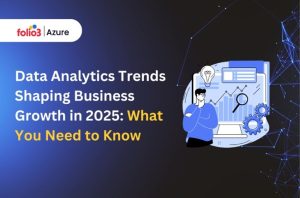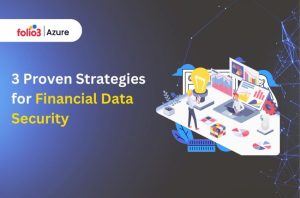Table of Contents
ToggleAmong the current volatile markets, tightening credit, and unpredictable customer behavior, cash flow visibility has become a lifeline. A staggering 82% of small businesses fail due to cash flow mismanagement (U.S. Bank study).
Traditional spreadsheets and static models are falling short. Business leaders today need agility, precision, and proactive insights—and this is where artificial intelligence (AI) steps in. By leveraging Azure’s cloud services, companies can build intelligent models that not only forecast cash flow but also automate allocation, detect anomalies, and simulate financial outcomes in real time.
This blog explores how to strategically build and deploy an AI cash flow model in Azure, examining the technologies involved, the business benefits, and real-world case studies. Whether you’re a CFO, finance manager, or IT leader supporting financial operations, this guide will help you comprehend the power of AI in managing cash flow.
What are the Benefits of an AI Cash Flow Model?
Before building your AI cash flow forecasting system in Azure, it’s important to understand why it matters. AI brings accuracy, efficiency, risk reduction, and adaptability to finance teams. Here’s how these benefits translate into tangible business value:
Accuracy that Drives Confidence:
AI-driven models sift through vast financial data to detect patterns invisible to manual methods. Studies show that AI-based cash forecasting can achieve an accuracy of ~90–95%. This precision lets companies anticipate surpluses or shortages and plan accordingly.
Rapid Insights through Automation:
Automating cash flow analysis with AI drastically cuts manual workload. Routine forecasting that once took days can be done in minutes, freeing finance teams for strategy. In practice, companies reclaim thousands of labor hours by replacing spreadsheets with AI tools.
Proactive Risk Management:
AI flags anomalies in receivables/payables data, surfacing payment delays or unexpected outflows early. By detecting these risks in advance, businesses mitigate liquidity issues before they become crises. For instance, AI can alert managers if incoming payments deviate from historical patterns.
Smarter Cash Allocation:
Insightful forecasts enable smarter resource allocation. AI-powered solutions highlight when cash will be available, helping decide whether to invest, hold reserves, or delay expenses. Integrating cash flow prediction with budgeting tools ensures working capital is used most effectively.
Scalability & Continuity:
Azure AI solutions scale with your business. Models trained on historic data stay robust as data volume grows. This scalability ensures that even large enterprises maintain accurate forecasting during rapid growth.
Want Better Visibility and Faster Insights?
Learn how an AI cash flow model improves accuracy, reduces risks, and scales with your growth.
Common AI Cash Flow Forecasting and Prediction Techniques
To maximize the value of AI, you need the right approach to forecasting. Here are the core techniques that power AI-driven predictions with more reliable and flexible forecasting:From Data to Prediction
AI cash flow forecasting blends historical transaction data (invoices, payments, wages) with machine learning to predict future cash positions. Modern tools use algorithms like regression, tree-based models, or neural nets to produce reliable projections.Scenario Planning
Forecast models aren’t limited to one path; they allow scenario analysis. Finance teams can simulate changes like altering payment terms or introducing early-pay discounts to immediately see effects on cash reserves. This “what-if” capability helps decision-makers choose optimal strategies (e.g., how much discount to offer for faster receivables) before acting.Cash Flow Prediction with AI
By continuously learning from new data, AI adapts to market shifts and one-off events. This is a step beyond static forecasting. AI can incorporate real-time signals (like sales trends or economic indicators) to refine predictions, turning cash flow forecasting into a strategic advantage.Steps to Build an Effective AI Cash Flow Model in Azure
Ready to roll out your AI model? Here’s a high-level guide to get you there. From defining business goals and preparing historical data to choosing the right ML model and deploying on Azure, this is a practical framework tailored to both finance and IT teams.
1. Define Clear Business Goals:
Start by specifying what you need from the model (e.g., short-term liquidity management vs. long-term planning). Align forecasting objectives with strategic goals based on risk reduction, cash runway, and investment timing. This focus guides data selection and model design.2. Collect and Prepare Data:
Gather historical cash flow data, including receivables, payables, payroll, tax payments, and related factors (sales volumes, seasonal effects). Clean and standardize it in Azure (e.g., Azure Data Factory into Azure Databricks). Quality data is the foundation because the quality and accuracy of your data will directly impact the performance of your AI cash flow model. Include enough history (ideally 1–2 years) to capture trends.3. Choose and Train the AI Model:
Evaluate model types (e.g., XGBoost, random forest, linear regression, or neural nets) based on your data’s characteristics. Use performance metrics (MAE, RMSE) to compare candidates on historical data. The right model balances accuracy and complexity: for instance, an ensemble might offer robustness, while a neural net can capture nuanced trends at a higher computational cost.4. Build in Azure
Leverage Azure tools to develop your model. Create a workspace in Azure Machine Learning or Azure Databricks. Use Azure Data Science and AI environments (or Microsoft Fabric’s data science experience) to code and train the model. For example, Azure ML Studio or Databricks notebooks support Python/R for data prep and ML pipelines. Use Azure DevOps for versioning and CI/CD of your modeling code. Evaluate the trained model’s accuracy and refine as needed.5. Deploy and Integrate:
Once validated, deploy the model as an Azure endpoint or batch pipeline. This makes real-time or scheduled predictions available to your business applications. For example, register the model in Azure ML and expose a REST API, or set up an Azure Databricks job. Connect the deployed model to finance systems using Azure Logic Apps or Functions. For instance, predictions can feed into Dynamics 365 Business Central or Power BI dashboards for visualization.6. Monitor and Maintain:
Regularly track model performance. Watch for model drift (e.g., if MAE/RMSE worsens) as business conditions change. Set up scripts or MLflow to automatically retrain the model on new data periodically. Ensure data quality with validation checks. This ongoing maintenance keeps forecasts reliable over time.Choosing the Right AI Model for Cash Flow
Choosing the right AI model is the foundation of an effective cash flow forecasting system. Different models offer varying levels of complexity, interpretability, and accuracy. So, your choice should align with the nature of your financial data and your forecasting goals.Linear Regression Models
These are the most straightforward models, perfect for businesses with consistent cash flow patterns and minimal seasonality. They provide easy-to-understand results and are useful for establishing quick baseline forecasts without heavy computation.Decision Trees & Ensemble Models
These models handle complex, nonlinear relationships in financial data. They work well for businesses with fluctuating revenues and expenses, enabling high accuracy across dynamic environments. XGBoost is especially popular for its speed and performance.Neural Networks
Long Short-Term Memory (LSTM) networks are designed for sequential and time-series data. Ideal for enterprises dealing with large, granular financial datasets, LSTMs can identify long-term dependencies and temporal patterns in cash movements that traditional models may overlook.Prophet (by Meta)
Designed for business analysts and finance professionals with limited ML expertise, Prophet excels at modeling seasonality and holiday effects. It’s ideal for companies with predictable, cyclic trends in cash flow, and can produce reasonable forecasts with minimal configuration.Hybrid Models
These combine the strengths of two or more model types. For example, a business might use XGBoost for short-term accuracy and LSTM for strategic, long-range projections. This approach increases reliability and allows for more adaptive planning.Criteria for Choosing the Right Model
- Forecasting Horizon: Choose simpler models for short-term needs and neural networks for long-range forecasting.
- Data Volume and Quality: Neural networks need large datasets, while Prophet or regression models can work with smaller or noisier data.
- Interpretability Needs: Decision-makers who prefer transparency may favor regression or decision trees over complex neural networks.
- Deployment & Maintenance: Consider ease of retraining, integration, and cost. Ensemble and hybrid models might offer accuracy but require more upkeep.
Azure Tools and Platforms for Cash Flow Modeling
Azure offers a robust ecosystem to support the full lifecycle of financial modeling. The following are the specific tools that empower seamless data flow, modeling, deployment, and visualization.Azure Machine Learning & Databricks
These cloud services provide pre-built environments for ML and big data. Azure ML simplifies model training and deployment, while Azure Databricks is ideal for large-scale data engineering and Python/R modeling. Both integrate seamlessly with Azure Data Factory and storage. For example, Azure Databricks can pull financial data from your ERP and feed it into Azure ML models.Microsoft Fabric / Synapse
Microsoft Fabric and Synapse Analytics also support data prep and machine learning. Fabric’s Data Science Experience offers a GUI for ML, suitable for teams less familiar with code. You can use these for end-to-end data-to-model workflows.Business Central Integration
Dynamics 365 Business Central has built-in support for Azure AI forecasts. Its assisted setup guides let you enable Azure AI predictive web services (no manual Azure coding required). Once enabled, BC automatically calls Microsoft’s cash flow forecasting service, giving an “out-of-the-box” AI-enhanced forecast.Visualization and Automation
After deploying, use Power BI or Excel to visualize cash forecasts for finance teams. Azure Logic Apps or Power Automate can trigger notifications or next-step workflows (e.g., alert managers when projected cash < threshold).Integrating and Deploying the Model in Business Processes
Once your model is trained and validated, the real value comes from seamless integration. Here’s how you can deploy it, ensuring that predictions translate into action across departments:Seamless deployment:
After your Azure cash flow model is live, integrate it with enterprise systems. For example, embed the model’s web-service endpoint into Business Central’s cash flow charts, or automate forecast updates via Azure Batch. OmniData recommends registering the trained model as an endpoint and creating inference pipelines so predictions can flow into dashboards.Connection to ERP/Finance Apps:
Use Azure Logic Apps or custom connectors to push model outputs into accounting software. For instance, if your model suggests a cash shortfall, it could trigger a procurement hold in ERP or send alerts to the treasury team. The model can even write recommendations (like optimized payment schedules) back into the system for action.CI/CD and Versioning:
Maintain models with Azure DevOps. Every model update (new data or algorithm tweaks) should be version-controlled. This ensures you can roll back or compare model versions as needed. Microsoft emphasizes using DevOps pipelines to deploy ML projects and manage releases.Security and Compliance:
Ensure Azure services comply with your company’s data policies. Azure ML allows role-based access, audit logs, and keys. Keep financial data secure through encryption and Azure AD.Automating Cash Flow Analysis and Allocation
Cash management doesn’t stop at forecasting. AI can automate the allocation of funds, match payments in real time, and optimize strategy. See the transition from reactive reconciliation to proactive, AI-powered allocation and decision-making.Automated analysis:
AI automates the heavy lifting of cash management. Instead of manual reconciliation, algorithms match payments to invoices and update cash forecasts in real time. For example, automated cash flow allocation systems “create matches of expected cash flow with cash in the bank” and then automatically apply strategies like setting payment times or interest adjustments.Efficiency gains:
Automated allocation tools reduce risk and errors. They ensure cash is applied correctly (reducing disputes or misallocations) and free up staff time. Real-time data capture means your cash position is always current. Overall productivity rises as staff focus on exceptions rather than routine entries.AI-enhanced allocation:
While classic allocation automates matching, AI can take it further by predicting the best allocation strategy. For example, an AI model could decide how to distribute limited cash among critical invoices to minimize late fees. This brings “automated cash flow allocation” into an intelligent domain.Continuous improvement:
With AI, forecasting and allocation form a feedback loop. The model learns from each period’s outcomes, improving future predictions and allocation strategies. This cyclic automation makes cash management adaptive and self-optimizing.Case Studies and Examples
Discover how real companies used Azure to implement AI cash flow models, leading to improved accuracy, saved hours, and better decision-making. These stories demonstrate the ROI and strategic gains possible through smart forecasting. Global Manufacturer (Meridian Adhesives): A multinational manufacturer implemented an AI-driven 13-week cash flow forecasting model. In just two months, the finance team and consultants built a system delivering weekly, data-driven forecasts across all business units. The CFO reported that the AI-enabled model “provides the data required to make informed decisions” on capital and growth. This real-world case shows how Azure AI techniques can unite disparate cash data into clear, actionable insight. Accuracy Gains: In practice, companies adopting AI report large gains. For instance, finance groups using advanced AI forecasts often see error margins shrink dramatically – one source notes up to a 50% reduction in forecast error compared to traditional methods. (Many enterprise Treasury departments are already deploying these models.) Productivity Impact: Another study found organizations reclaim 3,000+ hours annually by eliminating spreadsheet forecasting, thanks to AI automation. These hours are redirected to strategic analysis. This illustrates the human and cost benefits behind the technology.Conclusion and Next Steps
By now, it’s clear that an Azure-based AI cash flow model is more than a digital upgrade; it’s a financial transformation. CFOs gain near real-time insight into liquidity and can respond swiftly to change by combining predictive forecasting with automation. It’s your call to action for turning insights into impact.- Action plan: Companies should pilot AI forecasting on historical data: load past receivables/payables into Azure ML or Business Central’s AI service and compare results against known outcomes. Validate improvements in accuracy and gather user feedback from finance teams.
- Collaboration and governance: Involve both finance and IT in the project. Finance defines requirements, IT provides Azure expertise. Ensure data governance is in place (secure pipelines, access controls).
- Continuous evaluation: Treat the model as an evolving tool. Regularly retrain with new data, refine parameters, and expand to new scenarios (e.g., multi-currency or global subsidiaries). Over time, the system will mature into a core part of financial strategy.
- Long-term ROI: The strategic benefits – fewer liquidity surprises, optimized working capital, and informed growth planning can far outweigh the initial investment. As more enterprises embrace AI in finance, building an effective AI cash flow model in Azure becomes a competitive necessity.




